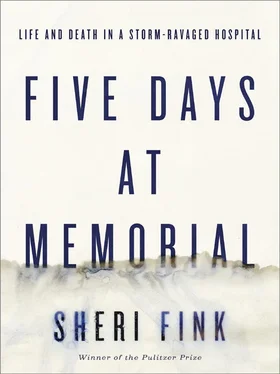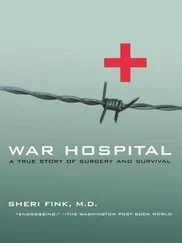The supplies that Mulderick and the maintenance crew had moved out of the basement during the storm had been restored shortly after it. Now teams of volunteers rushed to remove them again as water flowed up the drains, a reprise of 1926.
The pets, too, had been moved back down and were now being taken up to the parking garage facing Magnolia Street. Dr. Ewing Cook and his wife, Minnie, joined a procession bearing creatures and cages. The Cooks and their children and pets always stayed for hurricanes. Recently, not long after his son graduated from medical school, Ewing had retired from clinical practice. He now served as chief medical officer after working at the hospital for a quarter century. Minnie was one of several Baptist nurses who gave birth to daughters who grew up, studied nursing, and replaced them. Her daughter now worked in one of the ICUs with another second-generation RN, Lori Budo, whose mother had once been nursing director there.
The Cook entourage included their daughter’s three cats and Rolfie, her giant, furry Newfoundland. Minnie walked ahead with one of the cats and Rolfie on the leash, while Ewing followed dragging the dog’s four-foot-long, folded metal cage.
At the top of the staircase, Minnie turned and waited for Ewing, but he and the cage didn’t appear. “Dr. Cook’s down in the security office,” someone came up and told her. “You might want to go see about him.”
The sixty-one-year-old doctor had nearly passed out in the heat on his way upstairs lugging the forty-pound cage. A security guard had grabbed him and brought him to his office by the stairwell.
Minnie thought Ewing was having another heart attack. He’d had two, the most recent one only months earlier when he’d borne the pain like a stoic, continuing to load floor tiles into his car at Home Depot until she noticed he was gray and insisted he go to the hospital.
This time heat exhaustion had caused his symptoms. Cook rested, drank fluids, and recovered.
A RUSTING HELIPAD sat atop the hospital’s Magnolia Street parking garage on the southwest side of the campus, 114 feet above sea level. Memories of its use had faded like the blue letters painted on its tarmac: SBH, for Southern Baptist Hospital—the name the hospital hadn’t officially carried in more than a decade.
The helipad, known as a Helistop, had been opened with fanfare in 1985. In what only a hospital marketing newsletter would proclaim as a “time-saving, potentially life-saving feat of logistics,” the building project had involved extending the garage elevator two floors higher to allow direct helipad access from the hospital’s emergency room and sixth-floor maternity unit.
The Helistop had special features. Pilots could illuminate the landing lights remotely by setting their VHF radios to a particular frequency and pulsing the switch on their microphones. The lights alerted hospital staff to prepare for an arrival. Landings could take place day or night in most types of weather.
The elevators and the landing lights relied on electricity. From that standpoint, the helipad design no longer represented a time-saving or lifesaving feat. The garage elevators had not been wired to the backup electrical system, rendering them useless without utility power. It was now impossible to take a patient directly from within the hospital to the helipad.
Several hospital administrators and others trudged up the seemingly endless garage staircase to assess the situation. The picture of decrepitude that met them raised a more serious question about the Helistop. Would it buckle under the weight of a helicopter? The engineers in the group were unsure. Whereas the platform once could accommodate an aircraft weight of 20,000 pounds, the hospital had recently spent upward of $100,000 in repairs merely to keep it from collapsing onto the eight-story parking garage below.
One doctor lingered on the helipad after everyone else departed. Paul Primeaux, an anesthesiologist in a hospital where surgery was no longer being performed, was one of several physicians who had no clinical responsibilities because of the situation. (Others included two radiologists and a pathologist, doctors who didn’t normally see patients but provided critical services to them.) Primeaux had never been up to the helipad before and had joined the group out of curiosity.
Standing atop the thin platform was dizzying. Its flat edges dropped away to nothingness as breezes whooshed across it, unhindered by almost any other structure as tall as it for miles. Before him, to the west, the flooded streets of the Freret neighborhood stretched out like long mirrors, reflecting treetops and the top halves of double-shotgun homes. Southward, the land sloped up to the banks of the Mississippi River. Church steeples rose above debris-strewn rooftops. To the northeast, beyond the upper stories of the main hospital, he could see the skyscrapers of downtown a mile or so away and the Superdome, the city’s shelter of last resort. The storm had ripped away most of the gleaming white outer layers of its roof. The north side of the helipad led to the elevator tower through a tunnel full of glass from broken windows.
Primeaux heard the thrum of helicopter rotors and looked up at the sky. He saw a massive, dark-olive military helicopter with the numbers “585” painted in white across its nose. It looked like a Black Hawk. Primeaux gave it a casual, friendly wave. He did not mean to signal it, but the pilot began lowering his aircraft toward the spindly-legged helipad.
The Black Hawk, weighing more than 11,000 pounds empty, touched down. It sat, rotors spinning, framed by blue sky and wispy clouds. The helipad held.
The pilot asked Primeaux if there were people who needed to be evacuated. Primeaux said yes and suggested a sick newborn. The pilot checked with his commander and received permission to take one. Primeaux ran down the parking garage stairway and into the hospital to alert the incident command team. Then he went up to the neonatal ICU, where critically ill babies were being tucked into portable incubators, cradles, and cribs in preparation for transport.
The lack of functioning garage elevators turned the journey between the maternity unit and the Helistop from “immediate access” to long and circuitous. When the first baby finally reached the helipad, the waiting pilot was unhappy. “That took too long,” he said. Thousands of people needed help across the city. He had spoken with his commander and wouldn’t be returning. “You’ve got to figure out a better system.”

“OUR HELIPORT IS operational. We can receive air,” Memorial emergency communications leader Sandra Cordray wrote just after noon to Tenet’s regional business development director Michael Arvin at Tenet headquarters. The panicked calls and e-mails to make transport plans began to produce results. A hospital in Baton Rouge agreed to take all of Memorial’s babies; sixteen were critically ill. Coast Guard helicopters were expected to arrive in the afternoon to transport them and several adult ICU patients. The plan was coordinated with the help of a nurse’s husband who happened to be a junior grade lieutenant and medic working at the Coast Guard’s emergency command center in Alexandria, Louisiana. The National Guard promised to move thirty-five medical and surgical patients to a Tenet hospital in Texas via high-water troop hauler trucks with big tires and high platforms.
That would still leave well over one hundred Memorial patients and hundreds of other people in the hospital, and there were signs that government assistance might not be sustained. In the midafternoon, Arvin and his boss, Bob Smith—Tenet’s senior vice president for operations in the Texas–Gulf Coast region, a top official who reported to the company’s chief operations officer—received an e-mail with a desperate plea for help from the Federation of American Hospitals. “Senator Landrieu’s office called and is begging us to help them fill in emergency rescue gaps in Louisiana,” it said. “Apparently the state’s emergency response capability is falling woefully short.” Louisiana senator Mary Landrieu was asking hospitals in surrounding areas to lend their Medevac helicopters to help evacuate patients in the coming day. The author of the e-mail asked hospitals to respond “asap.”
Читать дальше













